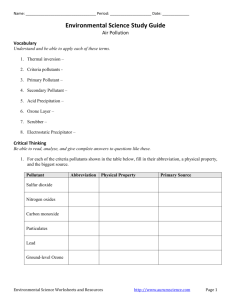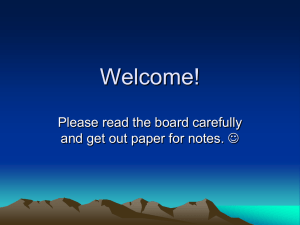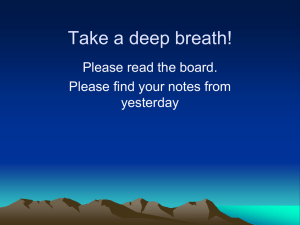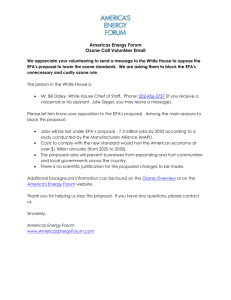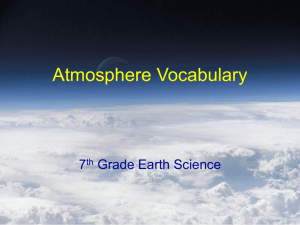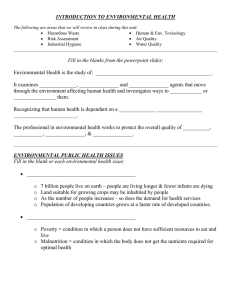Houston Air
advertisement
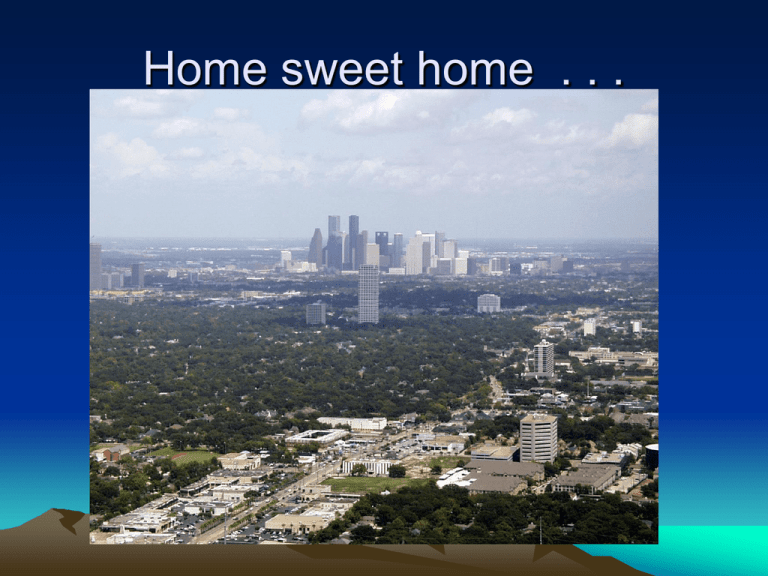
Home sweet home . . . Or is it???? Breathing! Some basics What is in our atmosphere? Normal chemical composition of our atmosphere: (N2) 78% (O2) 21% Trace gases (water, argon, carbon dioxide, other pollutants) 1% Pollution terminology • Pollutant • Source • Effect Article: EPA Proposes New Ozone Standard • EPA = Environmental Protection Agency Pollution units Parts per thousand (ppt) Parts per million (ppm) Parts per billion (ppb) Smog and ozone form together 1. 2. 3. 4. N2 + O2 2NO 2NO + O2 2NO2 NO2 + UV radiation NO + O O + O2 O3 Primary pollutants come directly from a source • Mobile sources Mobile sources Stationary Sources • Power plants Refineries Secondary pollutants form in atmosphere as gases react • Smog, ground level ozone and acid rain Secondary pollutants form in atmosphere as gases react • Step two: 2NO + O2 2NO2 • NO2 is smog – a yellow brown gas • Causes lung and eye irritation, makes asthma, bronchitis and emphysema worse Ozone formation Step 3: NO2 + UV radiation NO + O Step 4:O + O2 O3 Ozone slows photosynthesis, eye and lung irritant, makes asthma, emphysema, bronchitis worse Check out ozone formation • Texas Commission on Environmental Quality – EPA: National/Federal Regulatory agency – TCEQ: state regulatory agency • ozone animation Houston Clean Air Network Map AQI: set at 100 for each criterion pollutant level. Ozone 100 AQI = 85ppb Smog and ozone form together 1. 2. 3. 4. N2 + O2 2NO 2NO + O2 2NO2 NO2 + UV radiation NO + O O + O2 O 3 Ozone season: March- November Ozone daily formation: noon-early evening VOCs – a second route for O3 formation • Volatile Organic Compounds: – Methane (CH4) – Propane – Chlorofluorocarbons (CFC) – VOCs can break O2 into free oxygen atoms (free radicals) – VOC + O2 VOC + 2O – O + O2 O3 We're #? • . . . .for the number of days exceeding allowable ground level ozone levels. • American Lung Association State of the Air We're #? • . . . .for the number of days exceeding allowable ground level ozone levels. • American Lung Association State of the Air Measuring pollutants • • • • parts per thousand = ppt parts per million = ppm Parts per billion = ppb Parts per trillion = ppt (must know from context) Clean Air Act • Passed by Congress in 1970, updated in 1990, ‘93, 97, 2008. • Required EPA (Environmental Protection Agency) to identify criteria pollutants and to establish minimum standards: EPA came up with NAAQ’s National Ambient Air Quality Standards • Six criterion pollutants: NOx, SOx, O3, Pb, CO, particulates • Established minimum standards: 1hr and 8 hr • EPA is working to have greenhouse gases added by Congress to the NAAQs Houston’s special issues • 1/3 of all US petrochemicals pass through our refineries • Refineries separate crude oil into many different products from asphalt tar to gasoline to butane Refineries create carcinogenic air pollutants Benzene, toluene, ethylbenzene, xylenes So what is being done about this? - City monitoring 45 mobile monitoring stations State monitoring • Flexible permitting – each facility has total cap emissions limit, but flexibility in how they meet that limit. • TCEQ issues permits for emitting certain amount of pollutants • Facilities do “self reporting” Check your understanding! • What is the difference between a primary and a secondary air pollutant? • Give an example of a mobile source. • Give an example of a stationary source. • Which layer of the atmosphere are you in RIGHT NOW?!!!! • What is the normal chemical composition of our atmosphere?
